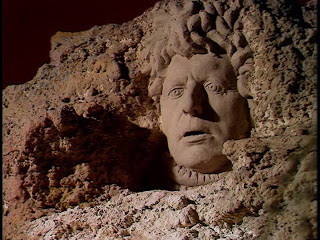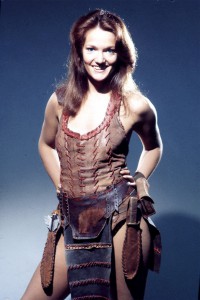 The TARDIS lands on an unnamed planet, where the members of a primitive tribe called the Sevateem all recognize the Doctor as “The Evil One.” It seems they have good reason: the Doctor’s face is carved into the side of a nearby mountain and they’ve been taught that’s the face of the Evil One. “Apparently I have been here before,” the Doctor muses. “I must have made quite an impression.”
The TARDIS lands on an unnamed planet, where the members of a primitive tribe called the Sevateem all recognize the Doctor as “The Evil One.” It seems they have good reason: the Doctor’s face is carved into the side of a nearby mountain and they’ve been taught that’s the face of the Evil One. “Apparently I have been here before,” the Doctor muses. “I must have made quite an impression.”
The Sevateem believe their god, Xoanon, is held prisoner by the Evil One and that it is their holy purpose to set him free. Their head shaman, Neeva, is the only one who ever hears Xoanon’s voice and our first assumption (along with that of a small dissident group in the tribe) is that he’s a mere charlatan. But we quickly learn that Xoanon is very real when we hear him talking to Neeva— and making things more confusing, Xoanon speaks with the Doctor’s voice. “What was that?” asks a young warrior of the dissident group, astonished to hear Xoanon’s voice coming out of thin air in the tribe’s shrine. “More to the point,” the Doctor replies, “Who was that?”
So who is Xoanon? Why does he periodically order the Sevateem to launch suicidal attacks against their hated but unseen enemies, the Tesh? And why is he so mad at the Doctor? This is a different kind of Dr Who story— it doesn’t center on a monster or an alien invasion (there are small horsehoe-crab type things called Horda, and some invisible “phantom beasts,” but just when it seems the story might turn into a base-under-siege against the phantoms, it goes in an entirely different direction). Instead this is about a world that has gotten terribly messed up— and the fact that it’s all somehow the Doctor’s fault.
It’s another good story from the Golden Age, though it has its flaws. Various would-be action scenes come across as strangely static and slow-moving, especially the ray-gun battles when the action moves to a spaceship, home of the Tesh, in the second half. Some of the characters are a bit wooden, although others are quite good. I’ll talk about Leela below, but also deserving mention are Caleb, a Sevateem warrior whose ambition is more important to him than the survival of the tribe and who switches sides whenever it suits him, and Neeva who gets to show surprising depth after (at first) appearing to be the villain of the piece.
Neeva’s character arc is especially interesting. We think he’s a charlatan, then learn he’s truly loyal to his god but since the god is a bad guy that doesn’t help us like him much, then when he learns Xoanon’s been lying all along he lapses into temporary shock— but then wakes up ready to join his tribe in fighting back. When the Doctor tries to get a message to the tribe by impersonating Xoanon through the radio link, Neeva seems at first to be fooled but then ends the conversation by saying “Yes— Doctor.” The Doctor muses, “I’ve underestimated that man.” Later, when Xoanon puts everyone under mind control, Neeva is the only one able to resist.
Overall, a mix of successful and unsuccessful elements keep this from being a best-of — but run-of-the-mill for the Golden Age is still pretty good.
Details
- The story was conceived and outlined by Robert Holmes and Philip Hinchcliffe, then assigned to new-to-Who writer Chris Boucher for the screenplay. Boucher will be more involved with Dr Who going forward.
- The Doctor gets a new companion, Sevateem warrior Leela (right). Hinchcliffe and Holmes wanted to go in an entirely different direction for the companion than Sarah Jane Smith. In place of journalist Sarah, who was best buddies with the Doctor (and clearly unimpressed by his ego), they had the idea of an Eliza Doolittle/Henry Higgins relationship with a companion the Doctor wanted to teach. But it would be boring if she was just the dutiful pupil waiting for the Doctor to pronounce truth at her. So they took the idea to its extreme and gave the Doctor a companion who literally starts from square zero, a warrior from a primitive tribe more familiar hunting wild game than running down corridors. Exiled from her tribe for questioning the existence of Xoanon, Leela is more than capable of taking care of herself (in an interesting twist on the past, since Tom Baker’s Doctor isn’t so much about physical combat, it’s Leela who will take on the action hero duties— to the extent that “stop killing people” will be the lesson the Doctor has the most difficulty teaching her) and also headstrong enough to get herself right into the thick of trouble, as the companion should (a member of the tribe’s dissident group, Leela got in trouble because she couldn’t keep her opinions to herself until they were ready for their attempted coup).
- Actress Louise Jameson says she based her performance as Leela, and especially the body language, on a combination of a three-year-old girl who lived next door to her, and on her own pet dog. She thought those sources between them gave the right picture of the savage Leela, from a society nowhere near civilization yet, still in its own early childhood.
- And of course her costume was entirely designed to get the Dads watching along with their kids. Jameson would frequently get very cold when shooting on location (England isn’t actually a tropical jungle) and says Tom Baker would wrap her up in his trademark scarf until cameras were ready to roll, at which point she’d have to spin her way loose like a top.
- Tom Baker had lobbied to have no companion at all, saying he could just have the Doctor talking to himself. Hinchcliffe and Holmes knew better (as demonstrated in the opening to this story, as the Doctor, arriving alone on the planet, does talk to himself at first, and it’s really just awkward— other versions of the Doctor can muse out loud, but the Fourth’s style of banter is really best employed to an audience). Resentful that his suggestion for a solo Doctor was rejected, Baker at first took it out on Louise Jameson, and their working relationship was not good at first. They patched it up later and neither minds talking about the rough start in more recent interviews.
- Leela has the distinction of being the first companion introduced in the wildly inaccurate Dr Who toy line from Denys Fisher Toys, a stupendously bad commercial for which can be seen here (warning, may cause psychological trauma).
Next Week:
“The Robots of Death” 4 episodes.


